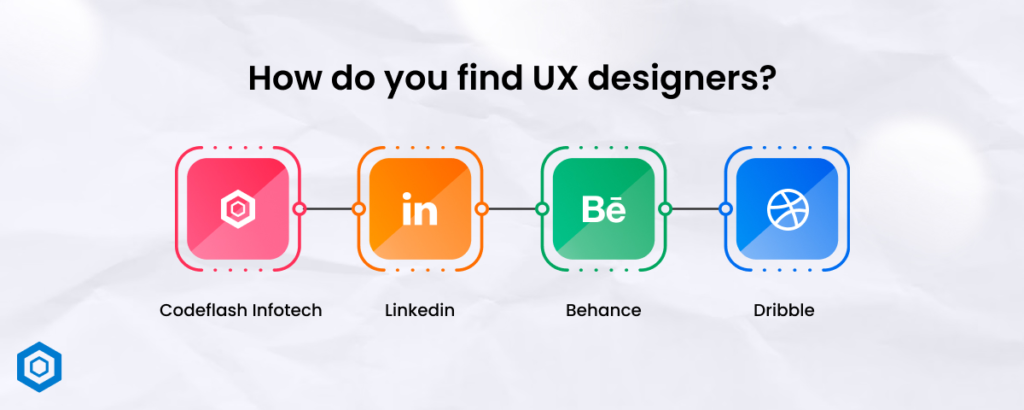
A Guide to Choosing the Ideal UX Designer for Your Design Project
01 MARCH
Choosing the Ideal UX Designer is a pivotal step for every product firm as they grow. With the increasing demand for UX designers reflecting a heightened focus on user experience in business, finding the right talent becomes essential. At our product design firm, we’ve been closely monitoring these ux/ui design trends and actively seeking new UX talent. Our lead designers, who are deeply involved in recruitment, have identified key red flags and green signs to watch for during applicant interviews to aid in this process.
How can you decide whether your team needs a Ideal UX designer?
Before proceeding, it’s essential to determine whether engaging a UX designer is necessary. With many design-related positions available, companies often need assistance distinguishing between them. Choosing the Ideal UX Designer ensures alignment in understanding. These professionals collaborate with the product team to simplify and enhance the user experience. They play a crucial role at every stage of the product design process, from research and user flows to wireframes, prototypes, and testing, closely collaborating with the entire product team.

A UX designer may be responsible for the following tasks, among others:
- Plans and Text
- Analysing competitors
- Analysis of customers
- Product design and approach
- creation of content
- Prototyping and Wireframing
- Wire-working
- Making prototypes
- Iteration and testing
- Planning for development
- Analytics and Execution
- Making prototypes
- UX iteration and testing
- Planning for development

How do you Choose the Ideal UX Designer?
Starting the search might be challenging if you’re new to hiring a designer. Fortunately, we have some helpful suggestions to guide you.
- Codeflash Infotech
In an ideal scenario, choosing a UX designer would be as simple as receiving a recommendation from a friend or colleague, similar to seeking referrals from other professionals like hair stylists or dentists. To Hire a UX Designer, explore reference sites such as Clutch, a B2B platform known for recommending trusted service providers. Many of our valued clients were referred to us through Clutch. Additionally, platforms like Upwork, Fiverr, and 99designs are excellent resources for discovering freelance UX designers, complete with reviews from previous clients. - LinkedIn
LinkedIn is only practical for some professions, but UX designers may try it. Find the personal stories of seasoned designers who work for firms you can trust to give you a sense of what a fantastic candidate might look like. LinkedIn’s work pathways and references are visible, although most designer profiles lead to portfolios. - Behance
The best resource for designers is Behance. The designer’s portfolio is the main emphasis of this website, and there are many excellent design examples. Behance examples allow users to share every step of the creative process, including behind-the-scenes moments when designers present their work and discuss their decisions and how those decisions affect the finished product, among other things. Make sure you thoroughly read this section.Visit our Behance page nowKey UX evaluation areas:
1) User flow enhancement
2) Effective user research methods
3) design alignment with corporate goals. - Dribbble
Dribbble caters to UX designers, while Behance is diverse. Despite more UX designers on Dribble, Behance includes all creatives. However, Behance’s photo-centric approach may need more comprehensive project details.In addition, if you don’t have enough time for a protracted hiring drive, ask for suggestions in a message posted on your company’s social media accounts and see what occurs. In this manner, you are more likely to attract eager applicants to work on your project.
Now that the theoretical portion of identifying a good UX has concluded, let’s get more down to business and discuss some stats.Visit our Dribbble page now
What to Look For in Your Interview
It’s crucial to have a chemistry session and come to an agreement with your UX design candidate(s) once you’ve exhausted the tiresome process of determining technical requirements and are prepared to select a UX designer.
Producing quality work is one thing, but to succeed, you also need to be working with someone you can rely on to uphold your goals and intentions in your work and who has the experience necessary to define requirements guided by shared values and genuine insight.
It is one thing to have a genius, but if they have several stewards in place—from technical to business to consumer—it is another matter entirely. If there is no relationship to the product, client, or associates, your boat can wind up at the docks.
List of UX Designer Interview Questions
Have you previously worked on a comparable project? What were the highs and lows of the event, and if any, what lessons were most important to learn?
- Have you had any experience working with a similar customer? Anything you would change throughout the procedure Working remotely or in large or small teams presents a variety of situations and obstacles. It is a good idea to decide how best to collaborate.
- Which role best captures who you are? Visual designer, art director, UX, etc.? And in that context, what are your most vital points? If you had any weaknesses, where do you think they would manifest themselves?
- “Moreover, concerning the challenges posed, which ones will you feel most confident taking on and resolving?” This is an important lesson since most people focus only on their perceived capabilities. It is essential to recognise what they need to accomplish better (regarding time and resources) early on and take steps to reduce those risks.
- What format is required for source handovers, and which UI tool will the team utilise—Sketch or Photoshop?
- “What messaging app will you prefer, Zoom, Slack, Skype, Trello, etc.?” Making the bed is always the most excellent option to start in the appropriate channels.
- Are you an independent learner? How do you manage your time, and do you prefer to set your own schedules?
- Having examined our brief, do you identify particular areas that warrant attention before delving into the outlined scope?
- “What time are you available right now? Can you work full-time/part-time/hourly? How long will it last? Three months or two weeks?
- “What are you most eager to complete with this project?” Additionally, specify which categories the project belongs under so everyone knows what to expect. For example, is it SaaS, eCommerce, onboarding, support, etc.?
Which UX designer level is a great fit?
Designer seniority is broken down into three basic categories customary in the computer industry: junior, medium, and senior. For what level is your project required? Let’s investigate.
- Junior-level UX designers
A junior designer of UX is a student. Typically, businesses choose junior designers to carry out straightforward tasks under the supervision of a medium or senior designer. A junior-level UX designer will help other designers with user flow modelling, wireframing, prototyping, and research. Therefore, adding a junior designer to the team might be wise if you currently have a senior or middle designer on your team and they want assistance with regular work. - Middle-level UX designers
A skilled practitioner with a few years of experience is a midrange UX designer. A middle-level UX designer will know how to use design tools well and can take on feature design responsibilities. They are required to suggest and defend design choices, and they can collaborate with developers, copywriters, and product managers. The central members of a design team are often middle designers. - Senior-level UX designers
A professional with at least five years of experience who can lead a team is referred to as a senior UX designer. A senior designer leads the team of designers and supervises their decisions in addition to creating the product’s UX strategy. If you require a professional to oversee your design team or someone with expertise in complex and specialised topics, hire a senior designer.
Rounding Up Your Requirements:
Since you now know what you need and who you want to collaborate with to develop your product, the remaining stages are straightforward yet crucial to establish.
- Deliverables and scope (expected/required)
- Schedules and objectives
- Specific needs (such as language proficiency, accessibility for blind people, etc.)
- Technology and specs (REST API, virtual/augmented reality, iOS/Android, etc.)
- Legal (other contracts, NDAs)
How do you choose the applicant that best fits your company?
- Evaluate the UX designer’s portfolio.
The first and most crucial item to consider when looking for a designer is their portfolio. A robust portfolio highlights seasoned UX designers’ abilities, expertise, and problem-solving approach. Look for a range of projects that show the designer’s versatility in working with various sectors and on various product kinds. Examine the projects in the portfolio’s usability, functionality, and visual design. - Conduct the interview
UX designer interviews focus on communication, problem-solving, and teamwork. Assessing these skills helps gauge the candidate’s suitability, aligning with standard professional interview principles. - Check your vibe
Sometimes, you can immediately sense if someone will fit in well with the firm or not just by touching them. Give the person a chance, of course. However, you should consider your intuition if you believe they won’t fit in with the company’s culture or be a good team player. In addition to performing poorly, a candidate in an improper position may cause disruptions to the workflow and their coworkers. - Hire the prospect
Once you have gone through the above 3 steps, checked their portfolio, conducted the interview and seen their team spirit, you can make them the offer and hire a UX designer for your company.
Conclusion
Choosing the Ideal UX Designer and UI/UX Design Company requires a clear understanding of the candidate’s expectations and job description details, considering variations in requirements based on organization size, industry, and project complexity. Consider collaborating with an agency if you need help with an internal designer. Codeflash Infotech is a pragmatic design firm prioritizing valuable design aligned with goals rather than solely focusing on eye-catching aesthetics. Our team of adept UX designers can begin your project within a week of initial contact.
Table of Content
How can you decide whether your team needs a UX designer?
A UX designer may be responsible for the following tasks, among others:
What to Look For in Your Interview
List of UX Designer Interview Questions
Which UX designer level is a great fit?
Rounding Up Your Requirements:
How do you choose the applicant that best fits your company?





